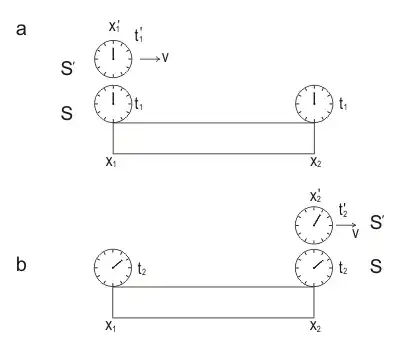There is a well known 2 mirror clock time dilation thought experiment in STR. However it is a bit unclear to me due to its unrealistic nature. By unrealistic I mean that experiment implies that stationary observer can immediately "see" the photon trace from side without photon actually hitting the detector (eye). As far as I know you cant see photon from side without it being absorbed by detector.
I am not sure I have understood you well, but in SR an observer does not look at the moving clock (light clock) from side. Since you call it "unrealistic" I'd try to shed some light:
In special relativity an observer is not a single person or human being, who sits on a bench and observes moving clocks. Stationary observer is the whole reference frame, or the team of observers. These observers stay apart from each other at certain distance and each has a clock. These clocks have been previously synchronized by Einstein signalling method (there is also Reichenbah's, which is self - consistent). They record space and time coordinates of events in immediate vicinity, or straight in front of each of them.
https://en.wikipedia.org/wiki/Observer_(special_relativity)
A stationary observer of reference frame $S$ conducts measurements this way:
He places light clock $C_1$ at coordinate $x_1$ of his frame and light clock $C_2$ at coordinate $x_2$ of his frame.
Let these light clocks have digital oscillation counters.
Then this observer sends a beam of light from clock $C_1$ towards clock $C_2$ when clock $C_1$ shows 0. He assumes, that one - way speed of light is c (Einstein synchrony convention). Since he knows distance and speed of light, he synchronizes these clocks, so as they show the same time in reference frame $S$.
https://en.wikipedia.org/wiki/Einstein_synchronisation
Imagine light clock $C'$ passes by clock $C_1$ first at moment of time $t_1$ and clock $C_2$ at moment of time $t_2$ then. At these moments, readings of the moving clock and the corresponding fixed clock of reference frame $S$ next to it are compared.


Let the counters of moving clock measure the time interval $\tau _ {0}$ during the movement from the point $x_ {1}$ to the point $x_ {2}$ and the counters of clocks $C_1$ and $C_2$ of the fixed or “rest” frame $S$, will measure the time interval $\tau$. This way,
$$\tau '=\tau _{0} =t'_{2} -t'_{1},$$
$$\tau =t_{2} -t_{1} \quad (1)$$
But according to the inverse Lorentz transformations we have
$$t_{2} -t_{1} ={(t'_{2} -t'_{1} )+{v\over c^{2} } (x'_{2} -x'_{1} )\over \sqrt{1-v^{2} /c^{2} } } \quad (2)$$
Substituting (1) into (2) and noting that the moving clock is always at the same point in the moving reference frame $S'$, that is,
$$x'_{1} =x'_{2} \quad (3)$$
We obtain
$$\tau ={\tau _{0} \over \sqrt{1-v^{2} /c^{2} } } ,\qquad (t_{0} =\tau ') \quad (4) $$
This formula means that the time interval measured by the fixed clocks is greater than the time interval measured by the single moving clock. This means that the moving clock lags behind the fixed ones, that is, it slows down.
The animation below depicts light clocks.

Sure, from the point of view of "stationary" observer $S$ beam of light moves by hypotenuse, though in "moving" frame $S'$ beam of light jumps up and down.
Good link: https://arxiv.org/abs/physics/0512013





